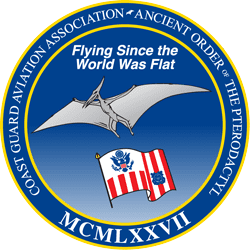In 1944 specifications were drawn up by the US Army Air Force for a 27 foot boat, with two engines, providing a speed of 8 knots, designed to be carried by an aircraft and dropped by parachute. The Higgins Company built the boat and it was in full production by January of 1945. The initial boats were configured to be carried by stripped down B-17 aircraft. The boat was faired into the belly of the aircraft and as a result produced little additional drag resulting in the loss of but 6 mph airspeed. The boat was usually released at a speed of 120 mph from an altitude of 1,500 feet. The boat proved satisfactory in operation.
During the last year of World War II and shortly thereafter, the US Navy acquired 48 former USAAF B-17s for ASW patrol work. Initially these aircraft operated under their original USAAF designations but at the end of July they were given a Navy designation of PB-1W. The B stood for Boeing and the W stood for anti-submarine warfare. This was actually a misnomer as the B-17s in question were built either by Douglas or Lockheed but Boeing had been the primary designer.

In July of 1945, 18 B-17Gs were set aside by the USAAF for transfer via the US Navy to the Coast Guard to be used as search and rescue aircraft. Rework began to convert the aircraft in question for search and rescue duties and provide for the carrying of droppable lifeboats. On 1 January 1946, the Coast Guard was returned to the Treasury Department, but nevertheless, the Navy continued to rework the B-17s and transferred the first of 15 to the Coast Guard in July of 1946. These aircraft were Lockheed-Vega and carried Navy serial numbers. An additional PB-1G was obtained directly from the USAAF in 1947 and it served with a truncated AAF serial number.
The PB-1Gs were stationed throughout the hemisphere and were used primarily for search and rescue purposes. They were also used for Ice Patrol and photo mapping. The photo aircraft carried a nine-lens, 1.5 million dollar, aerial camera for mapping purposes. Interestingly, the Norden bombsight, used by the B-17s in the bombing campaign against Nazi Germany was retained and was used to pinpoint targets for the camera.
The PB-1Gs were painted in yellow and black air-rescue markings and those utilized for search and rescue initially carried the droppable life boat. The PB-1G carried no armament and the B-17 chin turret was replaced by a search radar. The USAAF had made several successful lifeboat drops during the war but no record of an actual Coast Guard drop could be located. The Coast Guard PB-1Gs served well over a period of years – the last was not withdrawn from service until October 14, 1959.
| Manufacturer | Boeing: Built under License by Douglas and Lockheed-Vega |
| Designation | PB-1; PB-1G; SB-17G |
| Other Designations | “Flying Fortress” |
| Aircraft Type | Long Range Patrol; Search and Rescue |
| Wing Span | 103’ 9” |
| Height | 19’ 1” |
| Length | 74’ 4” |
| Fuel Capacity | 2,520 gallons; with auxiliary tanks up to 3,612 gallons |
| Max Speed | 310 mph |
| Cruising Speed | 200 mph |
| Range | 2,500 miles |
| Empty Weight | 36,135 pounds |
| Gross Weight | 55,400 pounds |
| Crew | 6 |
| Service Ceiling | 35,000 feet |
| Engines | Four 1,200 hp Wright R-1820=97 Turbo-charged |
| Propellers | Hamilton Standard 23E50 |

